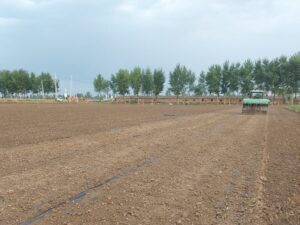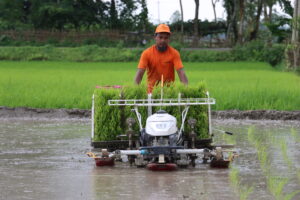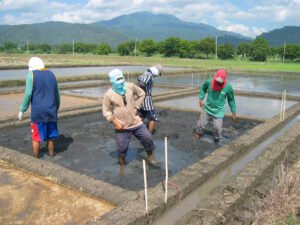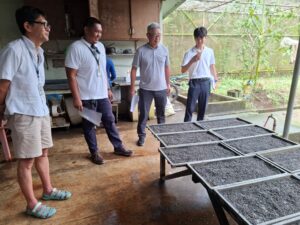By Prem Raj Bhatt, Mosharaf Hossain, Swati Nayak, Rabin Kushma Tharu, Jitendra Sah

Rice accounts for 53% of cereal grain production in Nepal and contributes 5.7% to the country’s total GDP and 13.5% to agricultural GDP (MoALD, 2023). Nearly two-thirds of farming households rely on rice farming for their primary source of income and nutrition, with rice providing 40% of the daily calorie intake in rural areas (Poudel et al., 2021).
However, despite its importance, the country continues to face a significant production shortfall. While the annual national demand is 4.08 million tons of milled rice, local production is only 3.25 million tons (Choudhary et al., 2022).
One key factor behind this shortfall is low yield. Although improved varieties have the potential to yield between 4.5 to 5 t/ha, average national yields only remain at 3.8 t/ha. Closing this gap requires access to high-performing, climate-resilient varieties and the establishment of an inclusive, efficient, and responsive seed delivery system.
IRRI’s Integrated Approach to Seed Sector Development in Nepal
Since 1996, IRRI has provided germplasm to Nepal, contributing to nearly 70% of the high-yielding rice varieties developed and released for irrigated and rainfed environments. Since then, IRRI has continuously strengthened its partnerships with the country’s national agricultural research and extension system (NARES), cooperatives, and private sector firms to address barriers in seed delivery and access.
In 2022, the Government of Nepal released seven inbred rice varieties developed through collaborative research between IRRI and NARES partners. These varieties, namely Ghaiya-3, Hardinath-4, Hardinath-5, Hardinath-6, Khumal Basmati-16, Ganga Sagar-1, and Ganga Sagar-2, are recommended for different farming conditions.
Field performances of these varieties were then assessed through cluster demonstrations and head-to-head trials. During the 2023–2024 seasons, Ghaiya-3 and Hardinath-4 demonstrated resilience in upland and rainfed conditions, yielding up to 5.5 t/ha and 4.2 t/ha, respectively. Meanwhile, Hardinath-6 and Hardinath-5 performed better in midland under irrigated conditions, yielding up to 4.6 t/ha and 4.2 t/ha, respectively. To complement these trials, over 100 hectares were utilized for cluster demonstrations, directly involving farmers to enhance their awareness and, in turn, increase local demand for these newly released varieties.
Facilitating Community-Based Seed Production and Women’s Economic Empowerment
To further efforts in promoting local seed availability and supporting farmer-managed production systems, IRRI collaborated with the Shree Krishna Mahila Krishi Sahakari Sanstha Limited, a women-led agricultural cooperative in Rautahat district. While the cooperative had prior experience in rice seed production, its varietal catalogue lacked access to recently released rice varieties due to limited market demand and reluctance to undertake risks associated with new seed multiplication.

With assistance from the National Rice Research Program (NRRP), IRRI supplied foundation seeds and provided technical training adapted to local conditions. Fifteen (15) women seed producers were able to multiply Hardinath-6, earning NPR 810,000 (around USD 5,900). Seed production operations throughout the broader Rautahat cluster generated sales worth NPR 1.8 million (USD 13,500).
Simultaneously, IRRI extended its support to Bardiya and Kailali districts. Jointly with NRRP and regional seed labs, 83 farmers (35% women) were trained on seed production, quality control, and marketing, while 56 seed producers (41% women) received technical assistance.

To enhance scalability and long-term sustainability, IRRI collaborated with private seed businesses and academic institutions, such as Global Agri-Tech Nepal Pvt. Ltd. (Banke), Panchashakti Seed Company Ltd. (Kailali), and the Faculty of Agriculture of Far Western University. These institutions received 1,320 kg of foundation seeds of the varieties Ghaiya-3, Hardinath-4, Hardinath-5, Hardinath-6. In 2024, this resulted in the production of approximately 83.5 metric tons of certified seed, of which 66.8 metric tons were bought by local cooperatives and local seed companies. The varieties provided a yield advantage of at least 0.4 t/ha, which helped enhance productivity and incomes of farmers.
The Need for Continued Investment on Seed Systems
Higher-yielding rice varieties have been introduced and disseminated through on-farm and cluster demonstrations, which have accelerated the adoption of high-performing rice in Nepal. Farm-level profitability rose as a result of these initiatives’ significant improvements to local supply chains and seed production.
In particular, increasing farmer competency, promoting inclusive participation, and growing climate-resilient varieties will require consistent investment in seed system improvement if the nation is to achieve a more resilient, equitable, and food-secure future.
References:
- Poudel, U., Kattel, R. R., Gurung, B., Shrestha, S., Paudel, A., & Paudel, A. (2021). Economic analysis of rice (Oryza sativa L.) cultivation in Gorkha district of Nepal. Archives of Agriculture and Environmental Science, 6(4), 489–497. [Online]. Available: https://doi.org/10.26832/24566632.2021.0604011
- MoALD, 2023. Statistical Information on Nepalese Agriculture. Singha Durbar, Kathmandu. Government of Nepal, Ministry of Agriculture and Livestock Development, Planning and Development Cooperation Coordination Division, Statistics and Analysis Section.
- Choudhary D, Banskota K, Khanal NP, McDonald AJ, Krupnik TJ and Erenstein O (2022) Rice Subsector Development and Farmer Efficiency in Nepal: Implications for Further Transformation and Food Security. Front. Sustain. Food Syst. 5:740546. doi: https://doi.org/10.3389/fsufs.2021.740546





